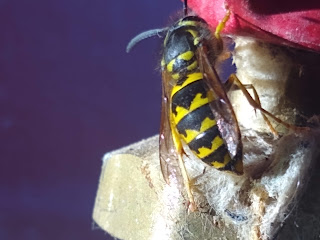There is a lot of parts to our bosque. Some of the bosque is permanent, like the water (-ish). Some of the bosque comes and goes, like green grass. The birds visit based on what is in the bosque. Some are year round, others only at certain times. Often, we only notice when things become very unusual, and often that's when it's too late to do anything. This why paying attention to the small changes can be very important; to be prepared.
This is the "armed" picture. Humans have seven neck bones, a heron has 20, plus one that is flexible and elongated. There is a bunch of other, weird stuff about their necks, but this blog can describe it better than me.
Usually I see killdeers in the summer, when they walk along the shores of shallow streams that have tadpoles in them. This one was snapping up some sort of aquatic insect species, or eggs. They are always moving.
I have heard of cedar waxwings in Corrales, mostly in the north end of the bosque where all the New Mexico olive berries are. This is the first one I've seen here. They are an uncommon visitor here in the winter. The recent cold front will often bring in odd birds. In April birders report many more of these distinctive looking berry eating birds.
If you look closer at the mallards gathering in the ditches, you can often see there are a few different species mixed up among them. The other green and cinnamon teal ducks are hard to spot, but these smaller wood ducks stand out because of their more skittish behavior. They have an odd whistling call and are the first to fly off when they see you.
The edges of fields that have young, dense stands of trees often will have flocks of small birds in the mornings. Near the Parks and Recreation center there is often a flock of bluebirds in the trees. While they are year-round residents, they are more visible during this time of year. This one looks like an Eastern Bluebird, but I am not the expert, so I follow the advice of the range maps.
No worries about this the house finch. These birds are found everywhere, all the time. This one is looking at grass seed that has been scattered on a dead patch on the soccer field. The males have a red cap and breast.The flicker has an amazing tongue, as all the woodpeckers do. The flicker is specialized for eating ants and it makes drinking water difficult. that's why this bird is doing a quick sun salutation and showing off it's trademark black gorget (throat).
Most bird baths are vital this time of year as most natural water sources are frozen in the mornings when the birds are looking to drink. Ice formations com ein many types. This twig has been exposed to moist air from the river, and the fine needles grew outwards into the vapor as the ice cooled
Many birds forage by the edge of the water once the mud has thawed. Here it is still solid, so no birds are wading along the shoreline
The bosque has many fruits that are edible, but not exactly preferred. This tree is a hackberry species many birds will eat the berries, but only if they have no other choices
This mild winter we are having means many insects will try to begin the mating season early. This will likely be a mistake. Many insects rest on the sides of walls. When they do, this false widow will be waiting this one was found in Taos, it is not related to the black widow. Actually, there are many spider species called the false widow, the scientific name of this particular one is Steatoda grossa. This is a male as it has red(-ish) legs. Black widows are in the Latrodectus genus and are unrelated.
This mayfly seems to have been recently hatched. During the spring and summer, many insects rest and develop their wings on the stucco. These wings are still rumpled and soft. This is likely the Baetis magnus, but I did not focus on the all important three whiskers on the tail to clinch the identification. Confusingly, this insect is best known because of trout fly fishermen, who call it by the name blue-winged Olive, because those are the colors used to tie the fly to a hook. The taxonomic knots these fishermen can bend themselves into, goes a long ways towards explaining why taxonomy is the most hated basic biology discipline. It is also rapidly disappearing as a skill in biology, to the detriment of everyone.
This is a fungus gnat. Species unknown. Some species actually use antifreeze proteins to be tolerant of cold weather. The grubs appear to eat just about anything.
Back in Corrales, bosque there is a burn scar from a 360 acre fire that started at the end of Romero Road in June of 2012. The hot fire laid down a waxy layer, reducing germination of new plants and keeping the soil too dry. The water table at this point is 12 feet down, which has to be reached for newly planted cottonwood trees to take root.
New shrubs need to be carefully selected, (not least of which is that there is no budget). Irrigation, full sun tolerant donated native shrubs and cottonwood poles, and volunteer workers are needed. The site has to be monitored over the years for vandalism, and fire has to also be prevented from recurring. Then, in 10-20 years, a different bosque might return with a bit of luck.
"A society grows great when old men plant trees whose shade they know they shall never sit in" - Greek Proverb



















No comments:
Post a Comment